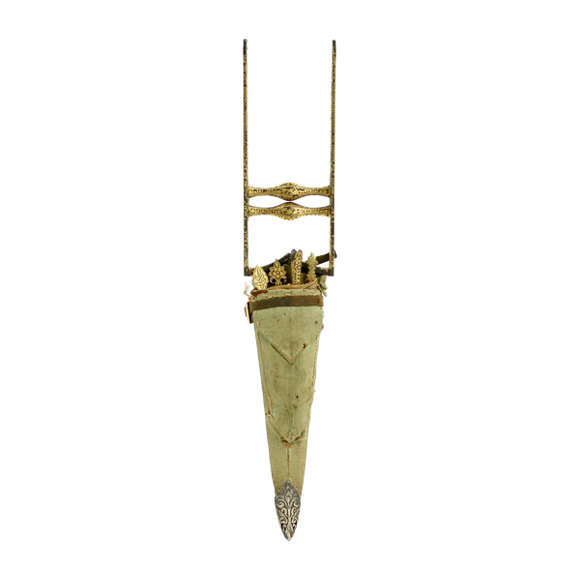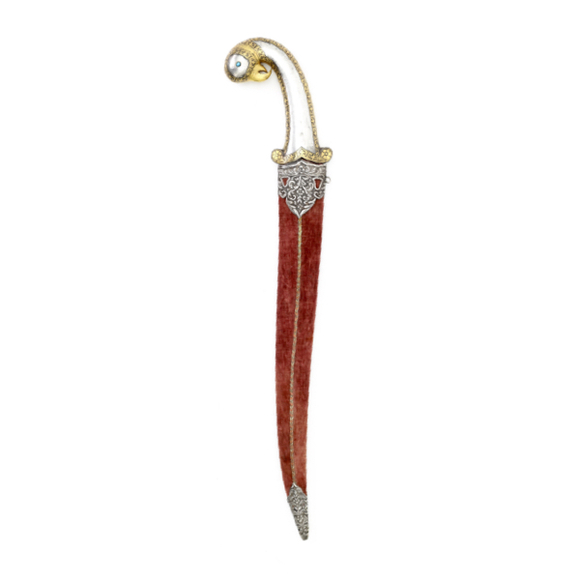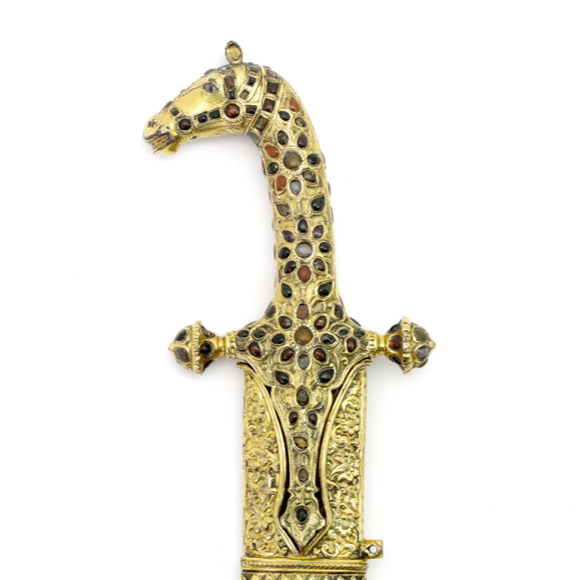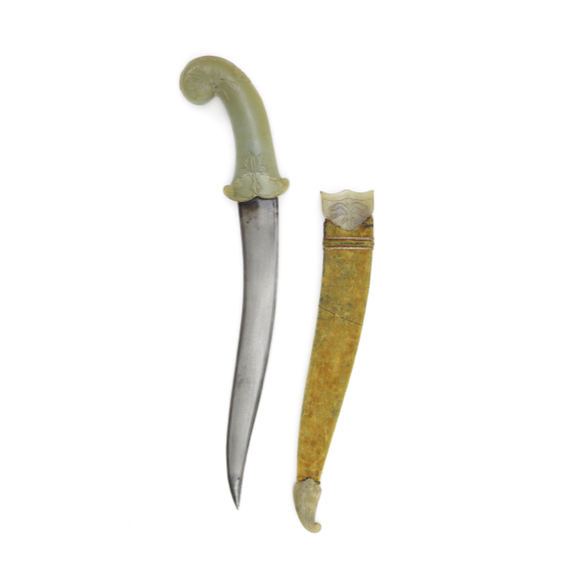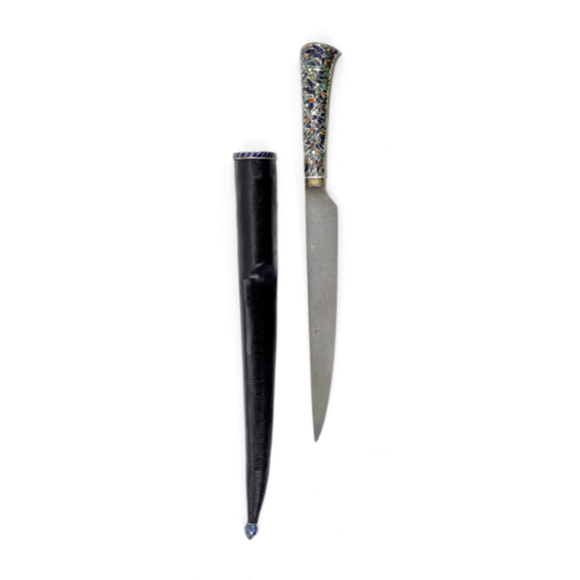With a fine wootz blade with a pronounced center ridge.

90.4 cm
78.8 cm
(tip to center crossguard)
Base 6.5 mm
Middle 5 mm
Start backedge 4 mm
5 cm from tip 2 mm
Base 31 mm
Middle 32.5 mm
Widest 34 mm
5 cm from tip 25 mm
882 grams
18 cm
from center crossguard
Iron, steel, resin, gold
Gujarat, North India
Blade 1693 A.D.
Later hilt
International antique market
Description
A fine talwar blade with a shape that gently widens from base to tip. It has two prominent grooves that meet in the tip section. The upper groove starts wide and then gracefully narrows to make way for a sharp backedge. Slightly hollow-ground edge from the emery-covered wheels used in India to sharpen these.
Original finish
The blade's surface is burnished, with the original burnisher's marks still present on the base. This is a very rare feature on talwar, which indicate they are in an original period finish. Many of these finishes have been lost either due to neglect, or often because collectors like to sand them down and etch the blades, looking for the forging patterns to appear.
While today many of us marvel on forge-folded blades, to the Indian warrior back in the day these patterns were the default. In their world, shiny chrome-like finishes were rarely seen, mirrors were terribly expensive, and so a totally burnished, mirror-finished blade provided something very exciting to the viewer. I am very glad to present a sword that still carries its original finish.

Markings
There are markings carved in the spine of the blade that appear to have been done by three different hands.

First, closest to the hilt is a number dot-punch mark in a style that reminds of those found on items from the Bikaner armory.1
૪૧૪૩
4143
Next is a place and date inscribed in lines appears to read:
वाकी कोट संवत् ૧૭૪૯ श्री
Vaakee kōṭa samvat 1749 śrī
Vaakee Palace 1749 samvat
(1693 A.D.)
And finally, another dot-punch mark:
૨૯ गुजरात
29 Gujarat
Vaakee Kota or Vaakee Palace, where palace can also be read as "city wall," is probably a place in Gujarat. The 4143 and 29 are most likely collection or armory serial numbers.
Gujarat was part of the Mughal empire. Mughal emperor Aurangzeb who was in power at the time of the blade's date, was born in Gujarat and served as its governor from 1645-1647. Ties between Gujarat officials and the central Mughal authority remained strong.
Notes
1. However the format differs, Bikaner serial numbers tend to start with the same, distinct mark. See my article The Bikaner Armory. But not all Bikaner items had these serial numbers, the talwar of Mohta Bakhtawar Singh that came from that armory for example, did not.
Hilt
The blade comes in a fine, but later hilt made of chiseled iron which was darkened by a deliberate patination process. Its decoration includes leaves and flowers in the typical Mughal style, over a lowered dotted background. The pommel plate is carved with designs of flowers and pierced. It has a dome on the back carved with acanthus leaves. All the carving is very nicely executed, and gold overlaid accents nicely contrast with the darker metal.

Carved floral elements in relief are a typical trait of 17th to early 18th-century work, and this work clearly intends to mimic that. The dark designs with golden highlights, however, betray a later aesthetic.
Such re-hilting was a common practice in India, and many other cultures where old blades were cherished but hilts were expected to conform to the latest fashions of the day.1
Notes
1. See for example Metropolitan Museum accession number 36.25.1591a, b for a 1673-dated blade with a 19th-century hilt. Or a talwar once owned by Shah Jahan (1592-1666) with a much later hilt sold at Sotheby's, Arts of the Islamic World, including Fine Carpets and Textiles sale of 24 October 2007, London, lot 246. Now in the Museum of Islamic Art, Doha, Qatar. And finally, a sword of Dara Soku, son of Shah Jahan, made 1640-1641 with mounts of a later date. Very different techniques are used, but the motifs are similar. Victoria & Albert Museum, accession number IS.214-1964.
Comparable hilts and their dating
Two such hilts were sold by Spink of London, one in 1992 that came from the Mark Zabrowski collection. Another was published in their 1994 exhibition catalog, "Treasures of the Courts," cat. number 25. Authors Simon Ray and Michael Spink dated it to the 18th century. The first was purchased by the Metropolitan Museum, which they initially cataloged as probably 18th-19th century but, in correspondence, thought to be later.
I personally think the group probably dates from the late 19th century. Of the three, mine was the only one that was mounted, and mine is the only one with convincing wear at the quillons and pommel, where gold wore off, and the iron is now patinated. All in line with how one expects a worn sword hilt to wear and age.

Indian noble families started to sell some of their armory inventory around the time that these hilts turned up, and I think that's their most likely provenance.
Notes
1. Of the six experts I consulted, three placed it in the 18th century, one in the 19th to early 20th century, and two in the 20th century.
Scabbard
It comes with an old, broken velvet-covered scabbard and a newly made wooden resting scabbard to protect the blade.
Conclusion
Talwar blades of this age and in this condition are rarely encountered on the market. Let alone in period finish, still carrying the burnisher's personal mark at the base.
The later hilt is beautifully carved, representing 17th-century Mughal art motifs but in a later color scheme to suit the fashions of a later period.


















The style typical of Kutch, the execution far above what is normally seen on work from that area.
Nice and complete with opaque green hilt and scabbard mounts.
With designs of animals, often attributed to Lucknow, north India.

